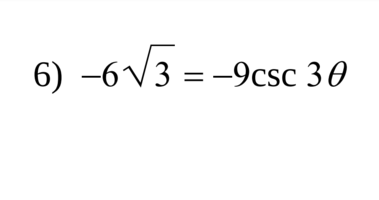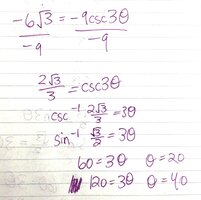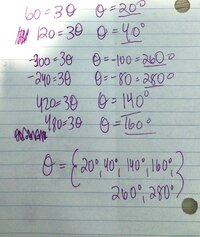You are using an out of date browser. It may not display this or other websites correctly.
You should upgrade or use an alternative browser.
You should upgrade or use an alternative browser.
Trig equation: Solve -6 * sqrt[3] = -9 * csc(3 *theta) for theta
- Thread starter Audentes
- Start date
You know cosec(x) = 1/sin(x)
and sin(A+B) = sin(A)*cos(B) + cos(A)*sin(B)
continue......
I divided both sides by -9 to get
2rad3 / 3 = csc3theta
arc csc 2rad3/3 = 3theta
arc sin 3/2rad3 = 3theta
arc sin rad3/2 = 3theta
60 = 3theta
where do i go from there?
Dr.Peterson
Elite Member
- Joined
- Nov 12, 2017
- Messages
- 16,863
First, isolate [imath]\csc3\theta[/imath].Good evening,
I am struggling with solving trigonometric equations. Could someone walk me through the following question:
View attachment 35520
Would really appreciate it, thanks!
FR
Then use that to find [imath]\sin3\theta[/imath].
Then find one angle that has that sine, and also another one, using the fact that an angle and its supplement have the same sine.
Now you have two possible values of [imath]3\theta[/imath]. But there are infinitely many more; write expressions that give all such values, by adding any integer times [imath]2\pi[/imath].
Finally, you can divide by 3 to find all possible values of [imath]\theta[/imath].
But you were probably taught all of this. What you need to do is to give it a try and show your work.
EDIT:
I see you did the first couple steps. To get one solution, you could just divide by 3; but you haven't told us whether you need to get all solutions, or all solutions within some particular interval, or just one solution.
I was asked to find solutions for theta being an angle from 0 to 360 (degrees)First, isolate [imath]\csc3\theta[/imath].
Then use that to find [imath]\sin3\theta[/imath].
Then find one angle that has that sine, and also another one, using the fact that an angle and its supplement have the same sine.
Now you have two possible values of [imath]3\theta[/imath]. But there are infinitely many more; write expressions that give all such values, by adding any integer times [imath]2\pi[/imath].
Finally, you can divide by 3 to find all possible values of [imath]\theta[/imath].
But you were probably taught all of this. What you need to do is to give it a try and show your work.
EDIT:
I see you did the first couple steps. To get one solution, you could just divide by 3; but you haven't told us whether you need to get all solutions, or all solutions within some particular interval, or just one solution.
What's next?First, isolate [imath]\csc3\theta[/imath].
Then use that to find [imath]\sin3\theta[/imath].
Then find one angle that has that sine, and also another one, using the fact that an angle and its supplement have the same sine.
Now you have two possible values of [imath]3\theta[/imath]. But there are infinitely many more; write expressions that give all such values, by adding any integer times [imath]2\pi[/imath].
Finally, you can divide by 3 to find all possible values of [imath]\theta[/imath].
But you were probably taught all of this. What you need to do is to give it a try and show your work.
EDIT:
I see you did the first couple steps. To get one solution, you could just divide by 3; but you haven't told us whether you need to get all solutions, or all solutions within some particular interval, or just one solution.
Attachments
Harry_the_cat
Elite Member
- Joined
- Mar 16, 2016
- Messages
- 3,779
Good so far, but you haven't found all the solutions required.
You are required to find \(\displaystyle \theta\) where \(\displaystyle 0^o < \theta < 360^o\).
So therefore you need to find \(\displaystyle 3 \theta\) where \(\displaystyle 0 < 3\theta < 1080^o\).
So, \(\displaystyle 3 \theta = 60^o\) OR \(\displaystyle 3 \theta = 120^o\) OR \(\displaystyle 3 \theta = 60^o + 360^o = 420^o\) OR \(\displaystyle 3 \theta = 120^o + 360^o = 480^o\) OR ...
.
There are two more coterminal angles to consider. Can you find them?
When you divide by 3, you should get 6 solutions for \(\displaystyle \theta\) which lie between \(\displaystyle 0^o\) and \(\displaystyle 360^o\).
You are required to find \(\displaystyle \theta\) where \(\displaystyle 0^o < \theta < 360^o\).
So therefore you need to find \(\displaystyle 3 \theta\) where \(\displaystyle 0 < 3\theta < 1080^o\).
So, \(\displaystyle 3 \theta = 60^o\) OR \(\displaystyle 3 \theta = 120^o\) OR \(\displaystyle 3 \theta = 60^o + 360^o = 420^o\) OR \(\displaystyle 3 \theta = 120^o + 360^o = 480^o\) OR ...
.
There are two more coterminal angles to consider. Can you find them?
When you divide by 3, you should get 6 solutions for \(\displaystyle \theta\) which lie between \(\displaystyle 0^o\) and \(\displaystyle 360^o\).
Is this correct?You are required to find \(\displaystyle \theta\) where \(\displaystyle 0^o < \theta < 360^o\).
So therefore you need to find \(\displaystyle 3 \theta\) where \(\displaystyle 0 < 3\theta < 1080^o\).
So, \(\displaystyle 3 \theta = 60^o\) OR \(\displaystyle 3 \theta = 120^o\) OR \(\displaystyle 3 \theta = 60^o + 360^o = 420^o\) OR \(\displaystyle 3 \theta = 120^o + 360^o = 480^o\) OR ...
.
There are two more coterminal angles to consider. Can you find them?
When you divide by 3, you should get 6 solutions for \(\displaystyle \theta\) which lie between \(\displaystyle 0^o\) and \(\displaystyle 360^o\).
Attachments
Harry_the_cat
Elite Member
- Joined
- Mar 16, 2016
- Messages
- 3,779
Your solutions are correct! Well done.
Just be careful not to write \(\displaystyle -100^o = 260^o\) etc. They are NOT equal, but they are coterminal.
Just be careful not to write \(\displaystyle -100^o = 260^o\) etc. They are NOT equal, but they are coterminal.
Thank you! ?Your solutions are correct! Well done.
Just be careful not to write \(\displaystyle -100^o = 260^o\) etc. They are NOT equal, but they are coterminal.



